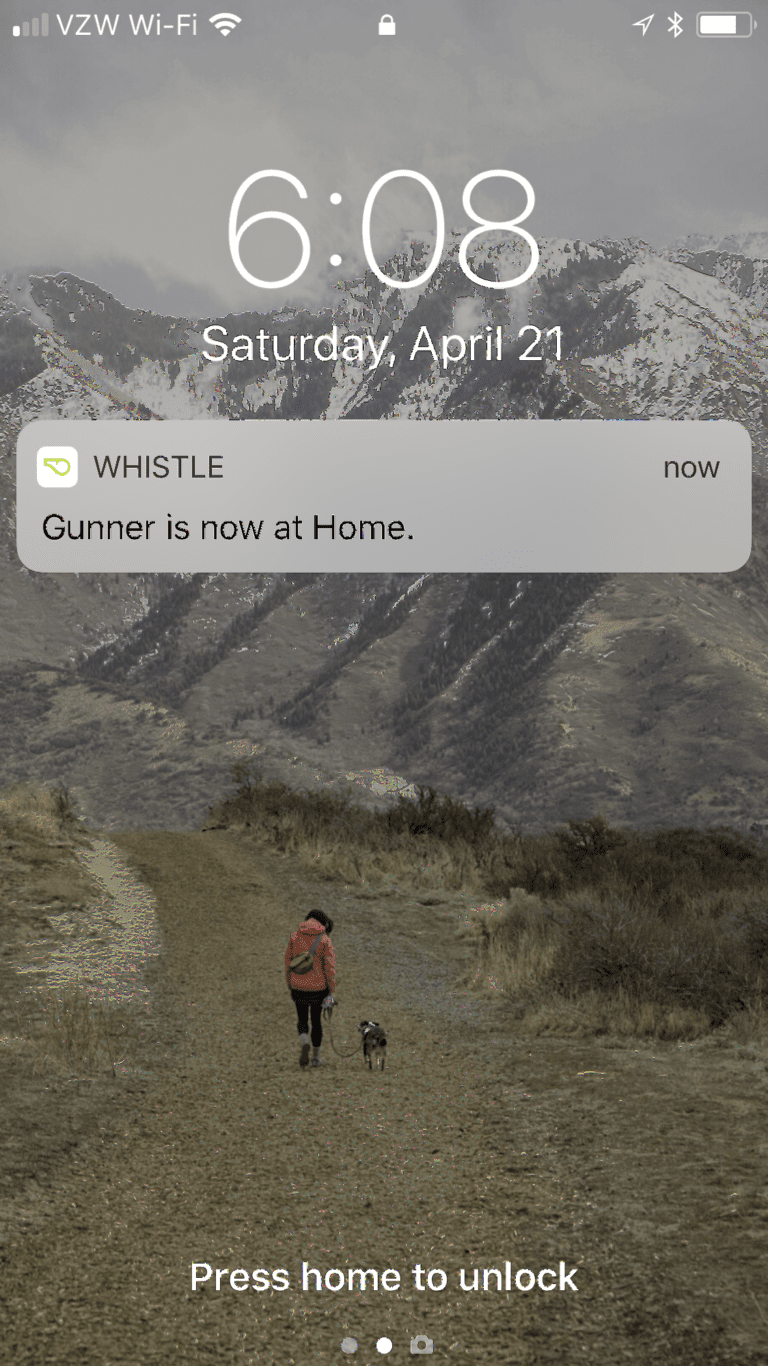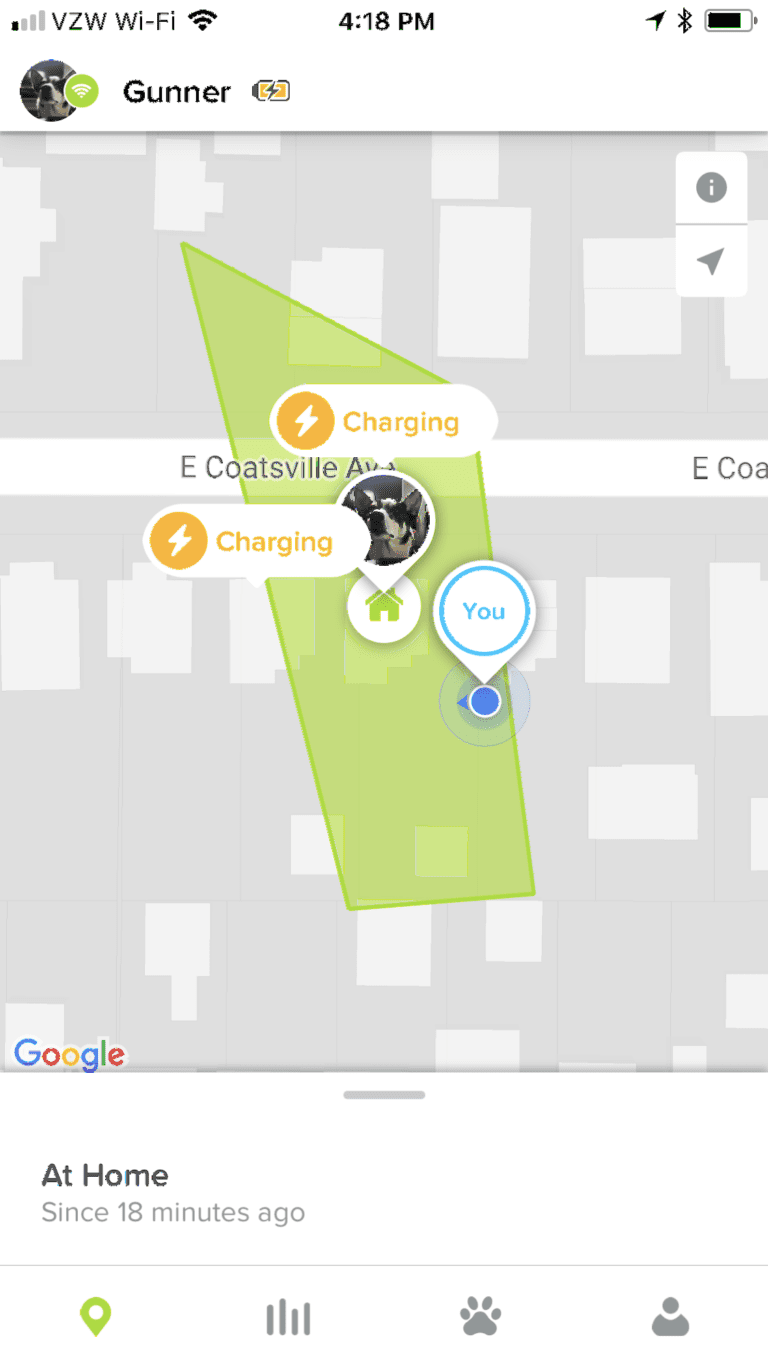Original SafeWise safety & security research featured in:
Whistle 3 GPS Dog Tracker Hands-on Review
For over 11 years, SafeWise experts have conducted independent research and testing to create unbiased, human reviews. Learn how we test and review.
The Whistle 3 uses a 3G cellular connection. It won't be usable after this year's 3G shutdown.
Whistle sells two other trackers that aren't affected by the 3G shutdown. View them on Amazon.
The Whistle 3 is a pet tracker and GPS device that attaches to your dog’s existing collar. The unit uses AT&T’s cellular connectivity, as well as GPS and GLONASS signals, to accurately track the location of your pet. So in the event that Fido escapes from the backyard, you’ll be able to ping her location on the Whistle app, find where she is, and leash her up before the dog catcher or city animal control gets called.
That said, the Whistle isn’t just a pet GPS tracker—it also monitors activity too. Specifically, it looks at calories burned and time spent resting or being active. This feature offers insight into your pup’s daily life and can help you adequately address health or mental stimulation.
We tested the Whistle 3 with the help of a playful senior husky named Gunner and found that most features work as expected.
Whistle 3 is easy to setup and use
The Whistle setup takes all of five minutes. All you have to do is charge the Whistle device, download the app, sign up for a subscription plan, make a profile for your pooch, and connect the GPS tracker to your Wi-Fi.
Once the unit is done charging, you’ll get a notification that the unit has finished charging and is ready to be fastened to your dog’s collar. Then, simply attach the Whistle 3 GPS Tracker to your dog’s collar and Fido is ready to roam.
Battery lasts a few days
You will have to recharge the battery every few days, depending on how frequently Fido wanders the neighborhood out of a safe zone or Wi-Fi connection area. The battery lasts longest when it's always connected to Wi-Fi.
Additionally, when your dog leaves the Wi-Fi range, Whistle’s app immediately notifies you that your furry friend is on the run.
Lightweight but somewhat bulky
The Whistle is relatively small and is intended to fit animals who are 8 pounds and heavier. However, the Whistle looked a bit large and unwieldy on Gunner, who weighs about 55 pounds. Consequently, this GPS pet tracker might be better suited for medium-to-large dogs, not small dogs. The convenient attachment piece keeps the Whistle securely attached to your dog’s existing collar instead of using a one-size-fits-all GPS dog collar or oversized pet tracking collar for dogs.
While most dog GPS tracking collars are oversized and heavy, the Whistle device is a bit more subdued and doesn’t seem to bother Gunner too much. The Whistle conveniently attaches to your pup’s existing collar, so your dog doesn’t have layers of collars and information tags jangling about. The only time that Gunner seemed bothered by the device was once when he laid down and the tracker was wedged strangely on his collar.
Whistle app

Screenshot: SafeWise
Since dogs don’t have thumbs, Gunner can’t comment on the Whistle app, but his human can tell you it’s simple and super easy to use—no unnecessary frills or baubles. The subcategory tabs within the app are self-explanatory and provide you with the perfect balance between thoughtful insight and daily stats. Our favorite is the activity monitoring section.
Customizable safe zones
A safe zone is an area like your home, friend’s house, or a doggy daycare center. You can add an indefinite number of safe zones to your pet’s profile. Just make sure that when you leave the house, the device is fully charged and securely attached to your dog’s collar.
Activity monitor
Whistle doesn’t just track Fido’s location—it also monitors activity (e.g. miles walked or run), rest, and calories burned. The activity tracking is comparable to the kind you’d find on your Apple Watch or Fitbit, but instead, the activity tracker is on your dog’s collar. Through the activity monitoring category of the app, you’ll receive recommendations that are tailored to your pooch’s lifestyle and age. You can adjust your pet’s goal physical activity at any point in time too.
Trip tracker
This convenient feature allows you to see where your pet has wandered in the past 24 hours. So say you forgot to lock the doggy door and Fido takes herself on a walk around the block—you’ll be able to see how far she meandered and where she went. Or, in the event that you employ a dog walker, you can check to see how far Fido walked during the day.
Geolocation sensor
Whether your furry friend has taken themselves for a leisurely stroll down Main Street or you’ve accidentally closed them in the garage, the Whistle’s location sensor helps you quickly determine where your pooch is hanging out. The garage bit is a true story—Gunner let himself into the garage, and his owner locked the door. Gunner’s human panicked because she couldn’t find him after 20 minutes, so she pulled up the Whistle app and realized he was just hanging out in the garage by himself—whoops!
Personalized profile
Whistle has a section dedicated to your dog’s profile—name, weight, age, and breed. In this tab, you’ll find owners (you can add multiple), activity goal, subscription plan, average activity, and device stats (e.g. battery percent and software updates).
What could be better

Screenshot: SafeWise
Inconsistent owner GPS location
This might seem nitpicky, and perhaps less of an issue with Whistle itself, but the app’s GPS map doesn’t have a consistent read on where you (the owner) are located. For example, I was less than two feet away from the Whistle Tracker, and according to the map I was in another house.
Inaccurate physical activity measurment
Your pup’s activity goal is measured in time spent away from a pet’s safe zone. If your dog plays in the house or backyard (within a safe zone), Whistle will make a note in the day’s activity barometer that some sort of exercise was conducted, but it doesn’t go towards the activity goal.
And Whistle doesn’t allow you to edit the type of activity or level of rigor—regardless of where the exercise occurred. As a result, the way that Whistle monitors physical activity doesn’t provide the most accurate representation of the intensity and type of exercise that your pup is getting.
Unpredictable signal or coverage
If you’re in a remote area or don’t have a remote hotspot, you won’t be able to receive a GPS geolocation on your furry friend. Yes, Whistle uses the best technology out there (GPS, GLONASS, and AT&T cellular coverage), but you’re not guaranteed a GPS location, alerts, or signal. There are some areas of the United States where you simply won’t have coverage.
Only available in the US
The Whistle GPS tracker is only available to dog owners who live in the United States. We hope the company makes a GPS pet and dog tracker for other countries as well, soon!
Final word
If you have an escape artist in the family and want a dependable dog tracking system, the Whistle Tracker will help you keep an eye on your furry friend. Additionally, the activity monitor provides insight into your dog’s needs and habits—and it’s a fun way to get the whole family involved in Fido’s well-being.
Whistle 3 FAQs
The Whistle has an IPX7 waterproof rating—so your pooch can go for a swim, roll around in the wet grass, and romp through muddy fields without breaking the Whistle.
No, the Whistle tracker does not have a heart rate sensor—it simply monitors for movement. That said, Whistle measures activity as time spent outside of a GPS-specific safe zone. In order for Whistle to accurately monitor activity, be it throwing the ball or going for a run, you and your dog will need to leave the safe zone and Wi-Fi network.
Yes, Gunner likes to run, wrestle, roll around in the grass, and play—and the Whistle device stayed securely attached to his dog collar the entire time. Gunner wears the Ruffwear Knot-A-Collar dog collar for reference.
No, the Whistle is very different from an in-ground fence or shock collar. The Whistle is designed to help you monitor your dog’s location, activity, and general well-being. A animal’s needs will vary from day to day, but if you’re a pet owner, meeting Fido’s needs are in your best interest. If you have a dog that jumps the fence or bolts, your furry friend might benefit from obedience training or more exercise.
A Wi-Fi connection allows the Whistle to update its software periodically and sync activity, GPS data, and trips accordingly.
The Whistle is best for dog owners whose pet is frequently off leash or escapes the yard often. As long as you have cell service, you’ll be able to access the Whistle app and your dog’s geolocation. Consequently, the Whistle could be ideal for hunters, outdoor enthusiasts, or people living in urban settings too.
How we evaluated the Whistle 3
To properly evaluate the Whistle 3 Dog GPS Pet Tracker, we read customer reviews, researched the company, and put the device through its paces with the help of our furry friend, Gunner. To find out more about how SafeWise researches and evaluates products, visit our Methodology page.
Related articles on SafeWise
Recent Articles









